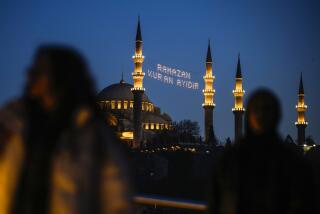The Fez Falls Victim to the Modern Times
- Share via
DAMASCUS — The last fez maker in Damascus bewails the disappearance of the round flat-topped hat, once worn with dignity as a mark of prestige in the Muslim world.
Salem Shamas has made, mended and ironed fezzes for over half a century, a trade that once occupied hundreds of hat makers in the Syrian capital.
Now even Shamas plans to get out of the business. It no longer provides a living and none of his children is interested in learning the fez maker’s skills.
Shamas has numbered Syrian and Lebanese presidents and heads of government among his clientele. But the reddish-brown tasseled hat has fallen victim to modern Western trends, as has another old Syrian tradition--the wearing of clogs.
‘Only a Memory’
“The fez and the clatter of clogs echoing through the city streets have become only a memory,” Shamas sighed.
“Today, I can’t see even one person wearing the fez, except for old men and Muslim clergymen, who cover it with their turbans,” he said.
“I used to sell over 20 fezzes a day, and more on Muslim feasts and special occasions. But now I only mend old fezzes or iron them. The special fabric from Austria, Egypt and Morocco needed to make them is no longer available,” he added.
Shamas pointed to several 100-year-old brass fezzes used to measure the size and shape of a customer’s head. “I don’t know what I’ll do with these when I close shop after 57 years,” he said sadly.
Old men in the region believe the fez originated in Albania and was spread through the Middle East during centuries of Ottoman rule. Turkey itself officially banned the fez in the 1920s as part of the young republic’s modernization drive.
Clog making is also a dying art.
“The clog used to be found in every bride’s trousseau,” said Hamza Mukhallalati as he watched an apprentice shaping one of the wooden shoes in his old Damascene shop.
“But the craft is threatened for lack of the special beech and walnut wood used to make them,” he said.
Only 25 years ago, more than 1,000 skillful clog makers plied their trade in the city, Mukhallalati said. Now only five small shops remain in the old clog market near the famous Omayad Mosque, and they do little business.
The few people still wearing clogs are mainly Muslim who don them to wash before prayers, said apprentice Deeb Sinan.
More to Read
Sign up for Essential California
The most important California stories and recommendations in your inbox every morning.
You may occasionally receive promotional content from the Los Angeles Times.













